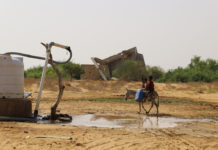This is part of my ongoing series on the Global Water Crisis which we have been tracking here at JB Shreve & the End of History
We have looked at the places in the world where the water is running dry in several posts already. There is a second global water crisis that is just as daunting. While much of the world is going parched, many other parts are sinking under too much water.

A study by the National Oceanic and Atmospheric Administration (NOAA) recognized an average sea level height from 2012 to 2016 to be about 4 inches greater than what was recorded two decades earlier.
Four inches might seem like a mere adjustment to where we should lay our sunbathing towels on a Miami beach, but it actually translates to much more. Rising sea levels mean changing weather patterns, and previously routine storms have today become emergency events. Such storms have also been the pivot points for the waters’ further encroachment onto Miami’s dry land. Once the waters advance upon the shorelines during massive storms, they are not returning to their prior pre-storm levels when the storm clouds blow away.
Miami is currently spending more than $500 million in a plan to elevate roads, install pumps, revamp drainage systems and raise sea walls. This is all part of an effort to save a threatened $40 billion worth of real estate in a tourist hot spot. Migration out of Miami has increased by 397% since 2010.

In Indonesia, the nation’s capital is sinking. The government is making plans to move the capital to avoid being underwater.
According to Laura Parker of National Geographic, more than 90 coastal cities in the US are battling chronic flooding that has become so rampant that a measure of population flight has already ensued from these areas. “By the end of the century, chronic flooding will be occurring from Maine to Texas and along with parts of the West Coast. It will affect as many as 670 coastal communities, including Cambridge, Massachusetts; Oakland, California; Miami and St. Petersburg, Florida; and four of the five boroughs of New York City.”

In Annapolis, Maryland, home to the U.S. Naval Academy, the town and campus are currently flooded on average 40 times a year. A report in the Navy Times in 2016 noted that the Navy Station Norfolk in Virginia and 17 other U.S. military bases located on the oceanfront property are expecting hundreds of floods a year and to be mostly submerged by the year 2100.
Louisiana’s struggles with rising sea level top all of what is taking place in the United States. Between 1932 and 2010, 80% of America’s coastal erosion occurred in Louisiana as 1,800 square miles of land disappeared under rising waters. Major storms like Hurricane Katrina in 2005 have added to the severity and drama in the southern state. Between 2004 and 2008, Louisiana lost more than 300 square miles to the ocean.

A study released last month examined how banks are responding to this growing concern and creating a potential economic crisis similar to the 2008 meltdown. Risky mortgages on properties in coastal areas that are sinking underwater are being shifted off of the banks’ books and onto the books of federal programs such as Fannie Mae and Freddie Mac. In other words, as property values begin to decrease through the effects of rising waters in these coastal areas, the big banks are finding ways to stick American tax papers with the bill – this is what happened in the 2008 mortgage and debt crisis. The great difference, however, is that these property values will not rebound. A home being “underwater” has previously referred to a situation in which the principal owed on a mortgage is higher than the market value of the home. Now it is quickly coming to have a more literal meaning.
The causes behind the rising seas are not uniform across the world. In some locations, it is the result of melting ice in the arctic. In others, it is the thermal expansion in warming ocean waters or the movement of local ocean currents. In Louisiana, technology and infrastructure built in recent centuries to reduce flooding risks along the Mississippi River have had the unintended consequence of preventing the flow of sediment deposits down the mighty Mississippi that previously worked to strengthen the coastal zones. This resulted in massive soil erosion. Adding to this, oil and natural gas drilling in the area since 1901 further weakened the soil, causing portions of the state to literally sink even as local sea levels are rising four times faster than the global average.
We have a global water crisis on our hands. In many parts of the world, there is not enough water and people are dying of thirst. At the same time migration out of major cities of the world is occurring as people flee the floods. This extreme contrast is indicative of deeper issues in our global system. As the root issues remain unresolved, we can expect this problem to grow much worse.

If you found this post informative, consider purchasing a copy of my latest book – How the World Ends: Understanding the Growing Chaos. Part four of the book examines the global water crisis in detail, both its causes and the growing ripple effects. You will also learn more about global food and population crises.


